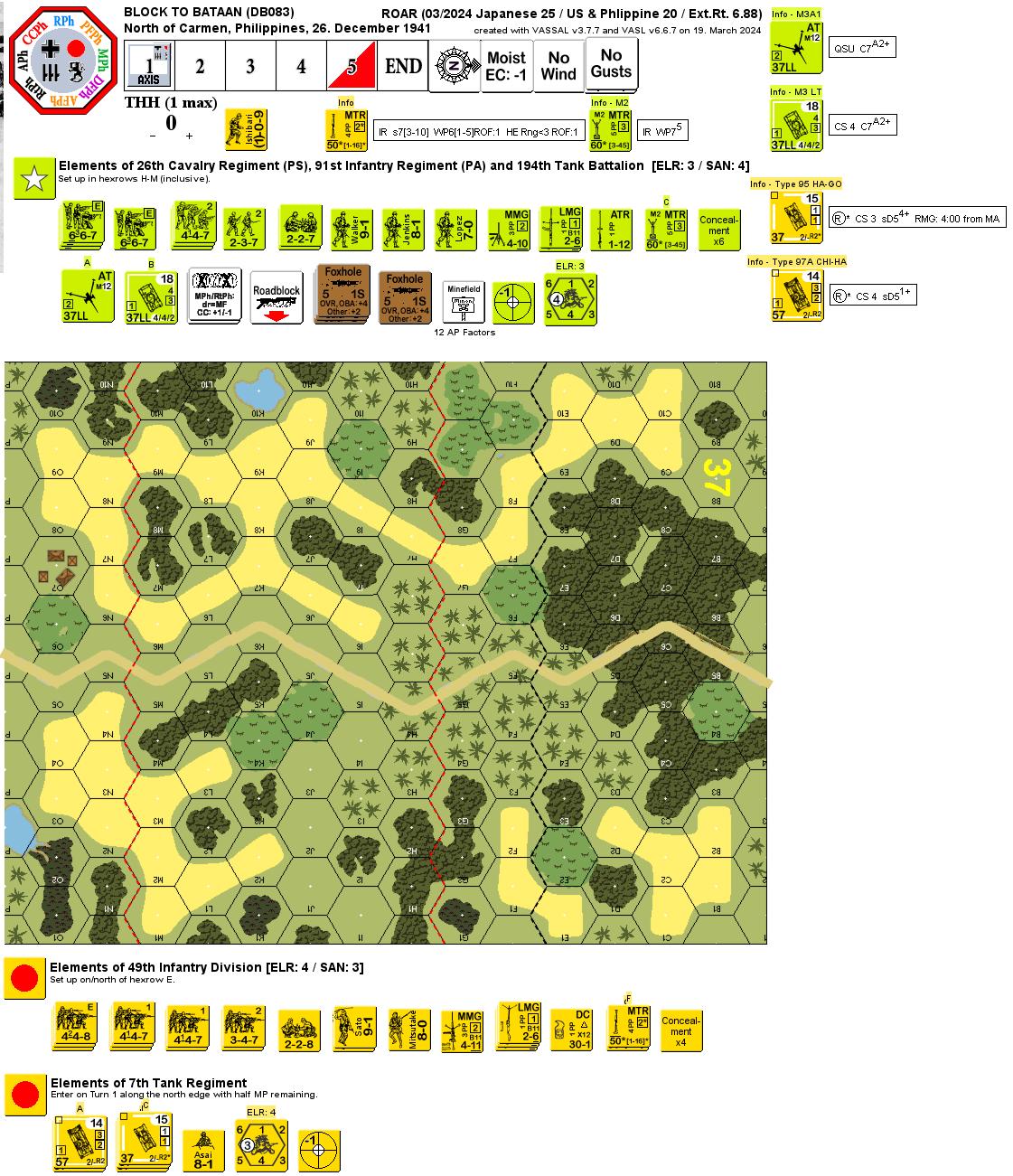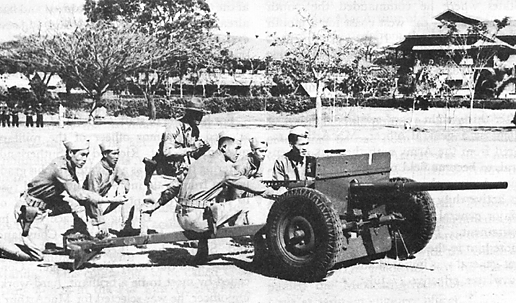| 2024-03-23 | (D) X von Marwitz | vs | Michael Koch | | Japanese win | | We are looking at an 1941 setting in the Philippines just after the landing of the Japanese. The US and Philippine Army desparately attempt to delay the Japanese onslaught to enable other troops to withdraw to the peninsula of Bataan. This scenario reflects the action around one of the roadblocks to hold back the Japanese to buy some time.
The forces for both sides are recorded in the Scenario Archive's data.
The attacking Japanese force is solid and has very good armored support in the form of five tanks and an Armor Leader. The tanks are radioless.
The US/Philippine defenders seem to have decent firepower and some fortifications to stem the tide. Any 37LL Gun lacks HE and uses Red TH#s by SSR, and there is no Canister available yet. The provided fortifications are helpful and necessary for the defenders, albeit not significant enough to build real "castles".
With 4.5 Turns, this is a typical short tournament style scenario with all the advantages and drawbacks these entail.
The objective of the Japanese is to clear a stretch of the road from GO enemy MMC & vehicles by game end.
I played the defending US/Philippine Army in this one (which are not the Scenario Defender as both sides set up onboard).
US/Philippine Defence Analysis:
The area in which the defenders may set up is pretty limited. This will make it nigh impossible to avoid Japanese Banzai Charges right from the start should these be planned. Mines and Wire should be considered to surprise the Japanese and to possibly disrupt such charges. The Japanese approach is helped by the terrain being full of Hindrances (PTO Light Jungle in effect, but Brush remains Brush). Due to this fact, the impact of the US firepower will be much reduced during the enemy approach, but Fire Lanes can be helpful. There are precious little sensible locations to set up the Roadblock, which is "open" to one flank. Therefore, it will most likely see use to provide a HD position for the single US tank and to block some LOS to the backfield.
As the Japanese have no less than five tanks entering in Turn 1 in the form of two Platoons with half MP remaining, the defenders will find it difficult to safely seal off all approaches with the anti-tank assets at hand. First and foremost, these are the 37LL ATG and the 37LL MA of the tank, which are both deadly to any Japanese armor fielded. Red TH#s for these tubes have hardly any impact, as the playing area is small and the numerous Hindrances will discourage most shots beyond the six hex range. While the two CHI-HAs are rather safe from US MGs, the three HA-GOs are vulnerable to MG and ATR fire. The US should strive to take out some of the enemy armor during the approach or else face the consequences...
With regard to the US/Philippine Infantry force, there is not much room and opportunity for maneuver. It has to sit more or less tight, allowing for minor tactical shifts, and hope for the best. There will hardly be any 'save havens' around for Rallying, so broken units will have difficulties to come back.
Only one MMC or Vehicle has to survive GO on/next to the stretch of road at game end on the 'bright side' of it (You explain this to the defending grunts to raise their morale...).
Japanese Attack Analysis:
4.5 Turns, no time to lose. The defenders move last in their Turn 4, which is to the attacker's benefit. You have two 50mm MTRs which are very important to create Smoke/WP cover for the approach. Much hinges on whether you can bring down this Smoke or not. Wire and Mines are out there, but there's no time for caution. Due to the Striping capability of the Japanese, they might just walk through Minefields without getting "stuck" in them broken. The Wire with its potential high MF cost to get beneath, however, could severely mess up Japanese Banzai Charges which is subject to Impulse Movement. Still, better to find Mines and Wire early to be able to subsequently move around.
The Japanese armor is a great asset despite the HA-GO's Gun having only doubtful punch vs. the enemy M3 LT. You will and can afford to lose tanks if the price is right. That said, you better take out that enemy M3 LT because it might otherwise screw you up in the end-game racing around to snatch away your victory. As Japanese tanks are radioless, they are subject to Platoon Movement. But checking with a Morale of 8, chances are pretty decent for successful solitary ventures. The US will not have many "kill stacks" around and freezing one of them might make all the difference to a Banzai Charge racing in for to the rescue.
The Japanese Infantry is powerfully led with two 9-1 Leaders. An effective squad morale of 9 or 10 is very hard to stop. The possibility of Deployment paired with a skillful setup of Banzai Charges will prove a daunting threat to the enemy. HtH combat by the Japanese can often kill superior numbers of the enemy. And if the Melee continues, the enemy is not Good Order. Still, HtH can play both ways, so near game-end, there is the risk that the US might win one returning to Good Order at the most inconvenient time.
How it played out:
I set up my defence in a way that the anti-tank assets could cover more than one enemy approach. Some posing and delaying forces were placed in the attempt to buy some time for the end-game. The Japanese attacked along both flanks with the Schwerpunkt on the US left flank (2 CHI-HA's, roughly 2/3 of the Infantry). The two other HA-GO's entered by the road to veer off towards the US right flank, one of them being picked off in the process.
Initially, Japanese Smoke was lacking, but later on it fell right where it was needed, seriously hampering defensive fire. One - somewhat charmed - HA-GO managed to reach the US back via the right flank to be finally taken out by MG fire. My opponent did not use large-scale Banzai Charges, but nevertheless, I was under serious pressure. This was because I rolled my shares of 11s and other crap (and I reckon someone else's to boot...). The most damage to the attackers was initially done by the Japanese himself which contrieved to roll boxcars on a MC for two 447s. I had lost my ATR, finally broken a LMG, and malfed the ATG which never came back with three enemy tanks still rampant.
Seriously hindered by Smoke I could not prevent the Japanese from closing in and swarming my precious M3 LT. It was taken out in CC along with an escorting Philippine squad, however, the latter improbably managed to take out the attacking 9-1, 448+LMG, and 347. For a brief time, the defence seemed to crystallize, when one of the CHI-HA's went down and the other immobilized on Wire, but then one of the key defending units broke and I missed three Rallies by one.
By the last Japanese half-turn, the Smoke had cleared and I had only just one Green Philippine squad left laying low in a Foxhole saying its prayers. Sure enough, any hopes were dashed as it went down thus bringing about the Japanese win.
Conclusion:
A good small scenario. The options for the defenders are somewhat limited. Due to having only 4.5 Turns, a lot can hinge on how the Japanese Smoke plays out or on how many of their tanks they might lose early or not. Overall, the scenario balance is all right with a small pro-Japanese tilt at 26 to 20 and a pretty good Excitement Rating of 6.65 by 40 players per ROAR as of March 2024.
von Marwitz |




